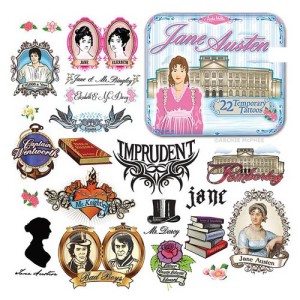June 22, 2015
I spent this past week-end at the Jane Austen Summer Program at the University of North Carolina, Chapel Hill, where I ate a great many scones; learned some things I didn’t know (at what times of day Regency folk ate); developed some sympathy for the odious Mrs. Elton (she too was an orphan, and her family may well have gotten their money in the slave trade); won a bonnet at the silent auction which I wore during my speech (but lacking a hat pin, I had to stop talking several times to deal with bonnet issues); and discovered that if you are wearing white gloves and make-up, you can’t touch your face. Not ever. (My gloves are currently soaking in Oxyclean. Bleach to follow.)
The UNC graduate students were marvelously good sports. They wore costumes, moved chairs, put on a play, handed out strawberries, appeared delighted to converse 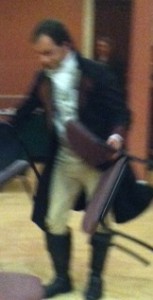 and dance with people older than their mothers, and generally seemed to be having a whole lot more fun than I ever had in graduate school.
and dance with people older than their mothers, and generally seemed to be having a whole lot more fun than I ever had in graduate school.
On Friday I wore my sprigged day dress. Two wome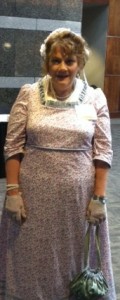 n, both very knowledgeable costumers (costumists?), wore period clothing the entire time, adding a great deal of spirit and information to the week-end. Hope Greenberg brought seven Regency gowns with her, and Ruth Verbunt, saying that Austen herself would have probably owned only four to six gowns at any one time, wore each of her dresses twice, showing how a simple da
n, both very knowledgeable costumers (costumists?), wore period clothing the entire time, adding a great deal of spirit and information to the week-end. Hope Greenberg brought seven Regency gowns with her, and Ruth Verbunt, saying that Austen herself would have probably owned only four to six gowns at any one time, wore each of her dresses twice, showing how a simple da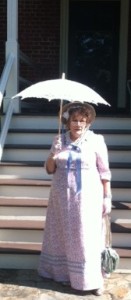 y dress could be re-accessorized into a ball gown.
y dress could be re-accessorized into a ball gown.
Ruth gave us a lecture on how to dress for a ball. Basically the make-up turns you into a corpse with a 105 degree fever (pale pale skin and two huge swatches of red rouge). She told those of us who did not come equipped with stays (the Regency version of a corset) to shorten the straps on a balconette bra as tightly as possible. The women in the crowd cringed. “Comfort, ladies,” she told us, “is not the goal.”
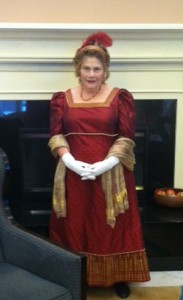 So when dressing, I obediently shortened my bra straps. I do not have a balconette bra (and actually wasn’t entirely sure what one was). This was not good. Shortening the straps on my non-balconette bra resulted in bits of the bra showing at the corners of my gown’s square neckline. By the time I realized this, it was way too late to start over (my hairdo involved three combs, four feathers, a bandeau, a borrowed brooch, two different pieces of fake hair, and countless bobby pins) so I needed to lengthen the bra straps without taking my dress off. Further complicating this was that the cuffs on my sleeves were quite tight. (They had been only a bit tight until I installed sleeveheads that raised and puffed the sleeves, thus drawing the cuffs up higher on my arm, making it so that I needed to check my fingers several times during the evening to be sure that they weren’t turning blue . . . but fortunately they remained make-up-tinged white all evening). Anyway it turns out that with such limited arm mobility you can’t lengthen bra straps and take a selfie at the same time so you will just have to imagine this pretty moment.
So when dressing, I obediently shortened my bra straps. I do not have a balconette bra (and actually wasn’t entirely sure what one was). This was not good. Shortening the straps on my non-balconette bra resulted in bits of the bra showing at the corners of my gown’s square neckline. By the time I realized this, it was way too late to start over (my hairdo involved three combs, four feathers, a bandeau, a borrowed brooch, two different pieces of fake hair, and countless bobby pins) so I needed to lengthen the bra straps without taking my dress off. Further complicating this was that the cuffs on my sleeves were quite tight. (They had been only a bit tight until I installed sleeveheads that raised and puffed the sleeves, thus drawing the cuffs up higher on my arm, making it so that I needed to check my fingers several times during the evening to be sure that they weren’t turning blue . . . but fortunately they remained make-up-tinged white all evening). Anyway it turns out that with such limited arm mobility you can’t lengthen bra straps and take a selfie at the same time so you will just have to imagine this pretty moment.
The ball, as had been the Regency card party the evening before, was held on the campus grounds in a building constructed in 1820. (The photo is from last year’s event.) Many people were in costume, and we began the ball with a grand promenade, following a bagpiper as we escorted our partners across the grassy lawns and brick sidewalks back into the assembly room. We then skipped with crossed hands during the Comical Fellow dance, swept up the ballroom in Mr. Beveridge’s Maggot, and managed not to hurt one another during Jackie Tarr.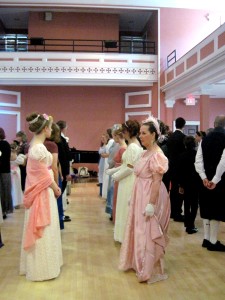
There were no History Police to criticize the authenticity of our garb. One woman had on a gown that would have been thirty or forty years out of date, but I figured that she was an impoverished clergyman’s daughter, the youngest of nine sisters, who had to borrow her grandmother’s dress if she were going to attend the ball. Some of the men wore period coats with Dockers and Topsiders, but who cared? Virginia Claire Tharrington, who is as delicious as her name, was totally Lydia-Bennett, wearing a white muslin gown with red dots, two big red bows on her shoulders, a red sash, and an explosion of black and red feathers in her hair. I think I spotted a zipper down the back, but that would have only made things even easier for Mr. Wickham, wouldn’t it?
Virginia Claire outdid herself and the rest of us the following day. She came as Cher Horowitz from Clueless in a teeth-jarring yellow plaid mini-skirted business suit.




 n’s novels for the love stories rather than the biting social commentary, who believed in the Victorians’ version of “dear Aunt Jane,” and who – worse – couldn’t finish Mansfield Park.
n’s novels for the love stories rather than the biting social commentary, who believed in the Victorians’ version of “dear Aunt Jane,” and who – worse – couldn’t finish Mansfield Park.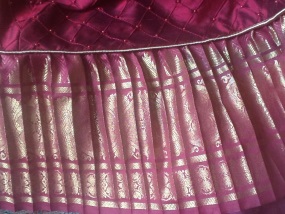 y sleeves? Not so good on me. So I instructed my computer program (Pattern Master Boutique from wildginger.com) to draft a more flattering profile. I ordered silk from the Internet and spent four episodes of Homeland ironing little pleats into the frill that would adorn my hemline.
y sleeves? Not so good on me. So I instructed my computer program (Pattern Master Boutique from wildginger.com) to draft a more flattering profile. I ordered silk from the Internet and spent four episodes of Homeland ironing little pleats into the frill that would adorn my hemline.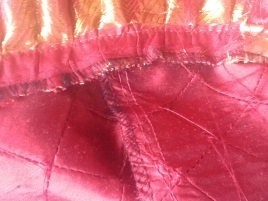 is rayon. I ordered the fabric off the Internet and used my computer to draft the pattern. I relied on my Rowenta steam-generator iron and my OttLit full-spectrum lighting lamp. I may be a failure in the historical department, but I had great fun, so much so that I made a second dress to wear during the day, and for it I went really crazy and used fusible tape to apply the trim.
is rayon. I ordered the fabric off the Internet and used my computer to draft the pattern. I relied on my Rowenta steam-generator iron and my OttLit full-spectrum lighting lamp. I may be a failure in the historical department, but I had great fun, so much so that I made a second dress to wear during the day, and for it I went really crazy and used fusible tape to apply the trim.